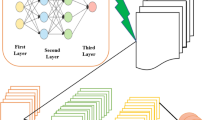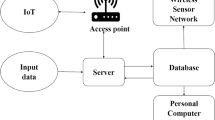Abstract
High-level athletes participate in various events that need extreme fitness and stamina. Usually, after competitions, the athletes take part in systematic physical fitness and specialized skills training. The daily training sessions of an athlete are often of higher intensity level. This kind of long-term and high-intensity training affects an athlete both physically and mentally and overloads him/her, leading to sports injuries. As a result, an athlete is no longer capable to perform high-intensity training due to these injuries and unable to achieve the desired results in the competition. Therefore, the need for an intelligent system arises to evaluate, predict and detect sports injuries effectively. The significance of neural networks for target recognition motivates us to propose a novel dual-feature fusion neural network model for athlete injury estimation. Our proposed model solves the problem of feature loss by using a 1 × 1 convolution and hyperlink to form a dual-fusion structure to enhance effective discrimination. Multiple experiments have been performed using different classification models. The performance of the utilized models, including the proposed model, has been evaluated with the help of numerous performance evaluation metrics. Various preprocessing techniques have been used in this study. The proposed model attained an excellent classification accuracy of 97.0%, a sensitivity of 95.70%, and a specificity of 97.54%. Experimental results show that the performance of the proposed model is much better than the rest of the classification models used in this study.









Similar content being viewed by others
References
Murphy DF, Connolly DAJ, Beynnon B (2003) Risk factors for lower extremity injury: a review of the literature. Br J Sports Med 37(1):13–29
Ba H (2020) Medical sports rehabilitation deep learning system of sports injury based on MRI image analysis. J Med Imaging Health Informatics 10(5):1091–1097
Palmer D, Cooper DJ, Emery C, Batt ME, Engebretsen L, Scammell BE, Budgett R (2021) Self-reported sports injuries and later-life health status in 3357 retired Olympians from 131 countries: a cross-sectional survey among those competing in the games between London 1948 and PyeongChang 2018. Br J Sports Med 55(1):46–53
Sillero-Quintana M, Gomez-Carmona PM, Fernández-Cuevas I (2021) Infrared thermography as a means of monitoring and preventing sports injuries. In: Research anthology on business strategies, health factors, and ethical implications in sports and eSports. IGI Global, pp 832–865
Davis WA 3rd, Yagnik GP (2021) In-season management of acute and subacute sports foot injuries. Foot Ankle Clin 26(1):187–203
Bolling C, Van Mechelen W, Pasman HR, Verhagen E (2018) Context matters: revisiting the first step of the ‘sequence of prevention’of sports injuries. Sports Med 48(10):2227–2234
Andreoli CV, Chiaramonti BC, Biruel E, de Castro Pochini A, Ejnisman B, Cohen M (2018). Epidemiology of sports injuries in basketball: integrative systematic review. BMJ Open Sport & Exercise Med 4(1).
Chang PD, Wong TT, Rasiej MJ (2019) Deep learning for detection of complete anterior cruciate ligament tear. J Digit Imaging 32(6):980–986
Ning X, Gong K, Li W, Zhang L, Bai X, Tian S (2020) Feature Refinement and Filter Network for Person Re-identification. IEEE Trans Circuits Syst Video Technol.
Jan MA, Khan F, Mastorakis S, Adil M, Akbar A, Stergiou N (2021) LightIoT: Lightweight and secure communication for energy-efficient IoT in health informatics. IEEE Trans Green Commun Netw, pp 1–10.
Ning X, Duan P, Li W, Zhang S (2020) Real-time 3D face alignment using an Encoder-Decoder Network with an efficient ddeconvolution layer. IEEE Signal Process Lett 27:1944–1948
Liu Q (2021) Aerobics posture recognition based on neural network and sensors. Neural Comput Applications, pp 1–12.
Ning X, Gong K, Li W, Zhang L (2020) JWSAA: Joint weak saliency and attention aware for person re-identification. Neurocomputing.
Cai W, Liu B, Wei Z, Li M, Kan J (2021) TARDB-Net: triple-attention guided residual dense and BiLSTM networks for hyperspectral image classification. Multimedia Tools Applications, pp 1–22.
Ning X, Wang Y, Tian W, Liu L, Cai W (2021) A bbiomimetic covering learning method based on principle of homology continuity. ASP Trans Pattern Recogn Intell Syst 1(1):9–16
Liu Q, Cheng L, Jia AL, Liu C (2021) Deep reinforcement learning for communication flow control in wireless mesh networks. IEEE Network 35(2):112–119
Liu R, Ning X, Cai W, Li G (2021) Multiscale dense cross-attention mechanism with covariance pooling for hyperspectral image scene classification. Mobile Information Syst.
Jianming Zhang, Juan Sun, Jin Wang, Xiao-Guang Yue (2020) Visual object tracking based on residual network and cascaded correlation filters. J Ambient Intell Humanized Comput. https://doi.org/10.1007/s12652-020-02572-0.
Ning X, Wang X, Xu S, Cai W, Zhang L, Yu L, Li W (2021) A review of research on co-training. Concurrency and computation: practice and experience, 2021.
Li Y, Zhang H, Shen Q (2017) Spectral–spatial classification of hyperspectral imagery with 3D convolutional neural network. Remote Sensing 9(1):67
Krizhevsky A, Sutskever I, Hinton GE (2017) ImageNet classification with deep convolutional neural networks. Commun ACM 60(6):84–90
He K, Zhang X, Ren S, Sun J (2016) Deep residual learning for image recognition. In: Proceedings of the IEEE conference on computer vision and pattern recognition (pp. 770–778).
Huang G, Liu Z, Van Der Maaten L, Weinberger KQ (2017) Densely connected convolutional networks. In: Proceedings of the IEEE conference on computer vision and pattern recognition, pp 4700–4708.
Zhang C, Li G, Du S, Tan W, Gao F (2019) Three-dimensional densely connected convolutional network for hyperspectral remote sensing image classification. J Appl Remote Sensing 13(1):016519.
Acknowledgements
This work was supported by Key R&D Projects in Shanxi Province. Project name: Exercise prescription for compulsory isolation of drug addicts based on data intelligence accurate recommendation system development. Item number: 201903D321039.
Author information
Authors and Affiliations
Corresponding author
Ethics declarations
Conflict of interest
The authors declare no conflict of interest.
Additional information
Publisher's Note
Springer Nature remains neutral with regard to jurisdictional claims in published maps and institutional affiliations.
Rights and permissions
About this article
Cite this article
Meng, L., Qiao, E. Analysis and design of dual-feature fusion neural network for sports injury estimation model. Neural Comput & Applic 35, 14627–14639 (2023). https://doi.org/10.1007/s00521-021-06151-y
Received:
Accepted:
Published:
Issue Date:
DOI: https://doi.org/10.1007/s00521-021-06151-y




